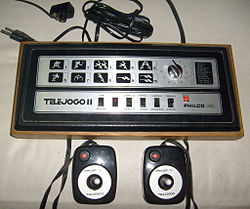 A Telejogo II | |
| Manufacturer | Philco, Ford |
|---|---|
| Type | Dedicated home video game console |
| Generation | First generation |
| Release date | 1979 |
| Predecessor | Telejogo |
The Telejogo II is a dedicated first-generation [1] home video game console that was manufactured by Philco and Ford and released in 1979 in Brazil as the successor to the 1977 video game console Telejogo. [2]
Contents
In contrast to the predecessor, the paddles are no longer attached to the housing of the console itself, but are removable. [2]
